psychology- competitive pressure.
1/73
Earn XP
Description and Tags
arousal, stress, anxiety and aggression.
Name | Mastery | Learn | Test | Matching | Spaced |
|---|
No study sessions yet.
74 Terms
arousal
a pattern of activities,both physiologiical and cognitive, that prepares us for a task.
who developed the factor of arousal and when
cashmore in 2008
who developed the drive theory and when
hull in 1943
draw hull's drive theory.
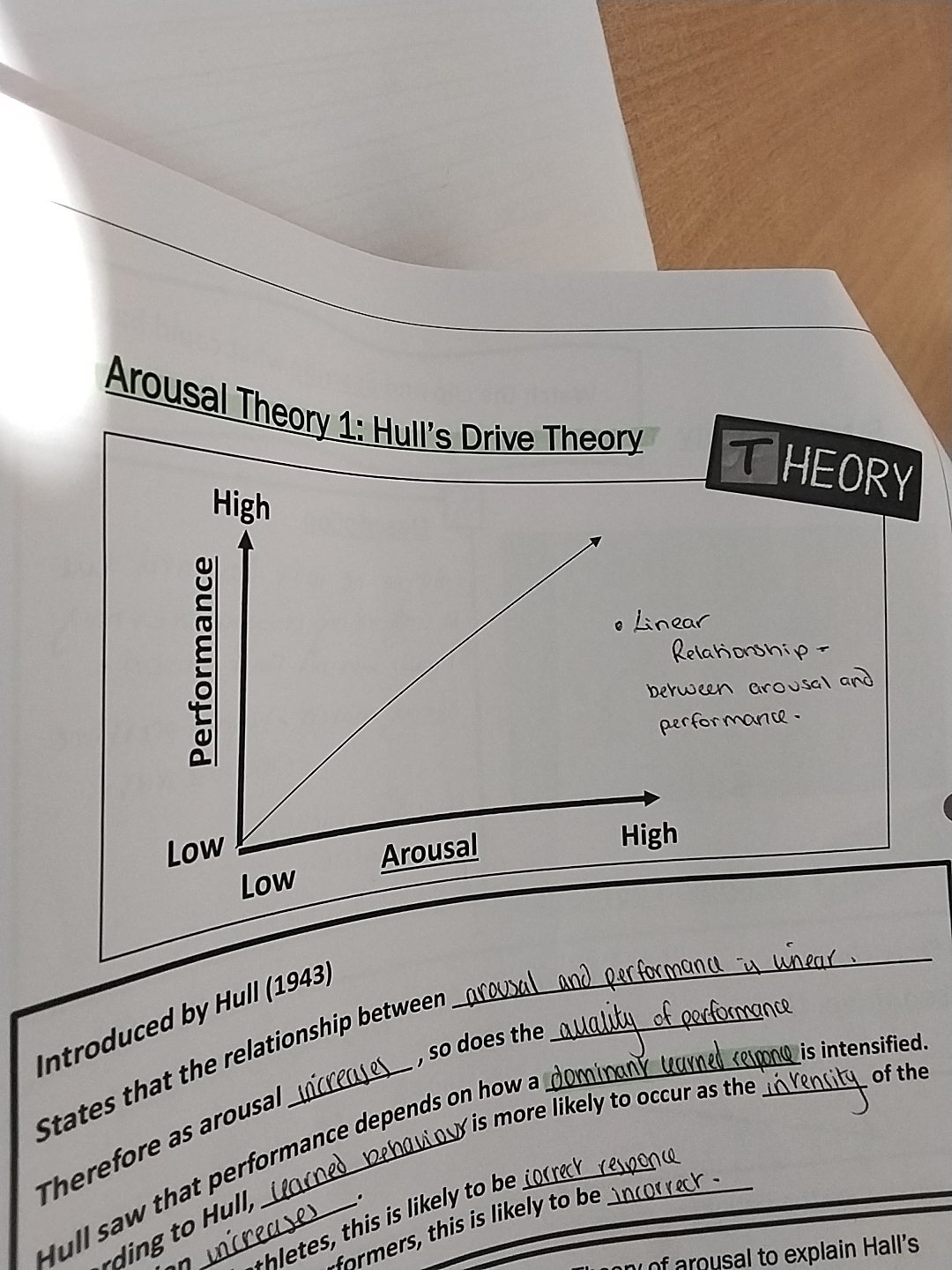
what is the relationship between arousal and performance according to hull
linear relationship.
as arousal increases what happens to performance according to hull
as arousal increases, performance increases
what does performance depend on according to hull
how a dominant learned responce is intensified.
learned behaviour is more likely to occur as the intensity of the competition increases.
who introduced the inverted U theory and when
Yerkes-Dodson in 1908
draw the inverted U theory
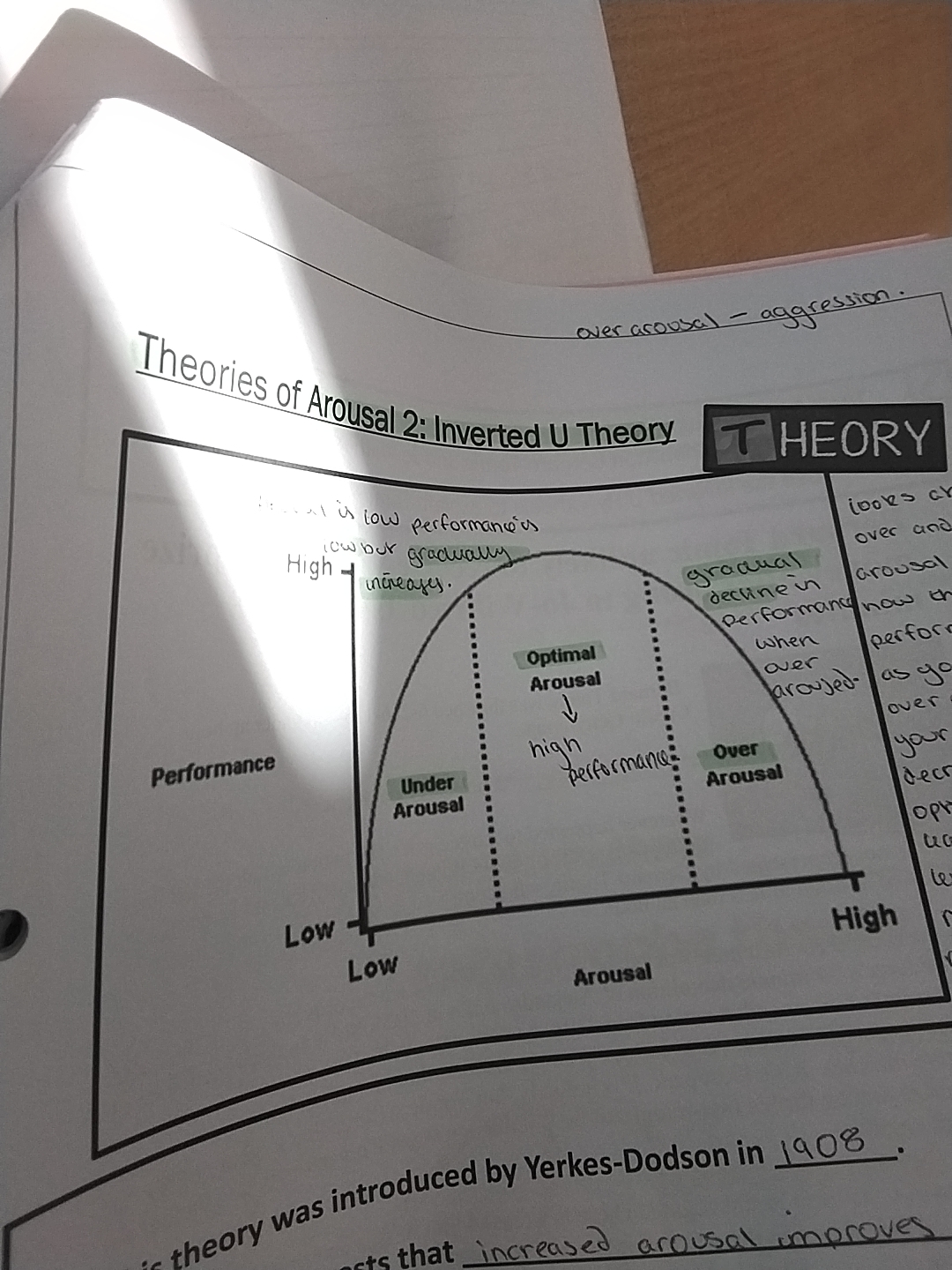
what does the inverted U theory suggest
increased arousal improved performance to an optimum point. After this point,anxiety inhibits performance due to over arousal.
what causes poor performance according to the inverted U theory
low level physiological or psychological arousal.
what happens after optimum arousal according to the inverted u theory and why
gradual decline in performance from the optimal point due to being over aroused and stressed/anxious.
what would over arousal involve according to inverted U theory
losing focus, poor decision making, aggressive behaviour.
draw the catastrophe theory.
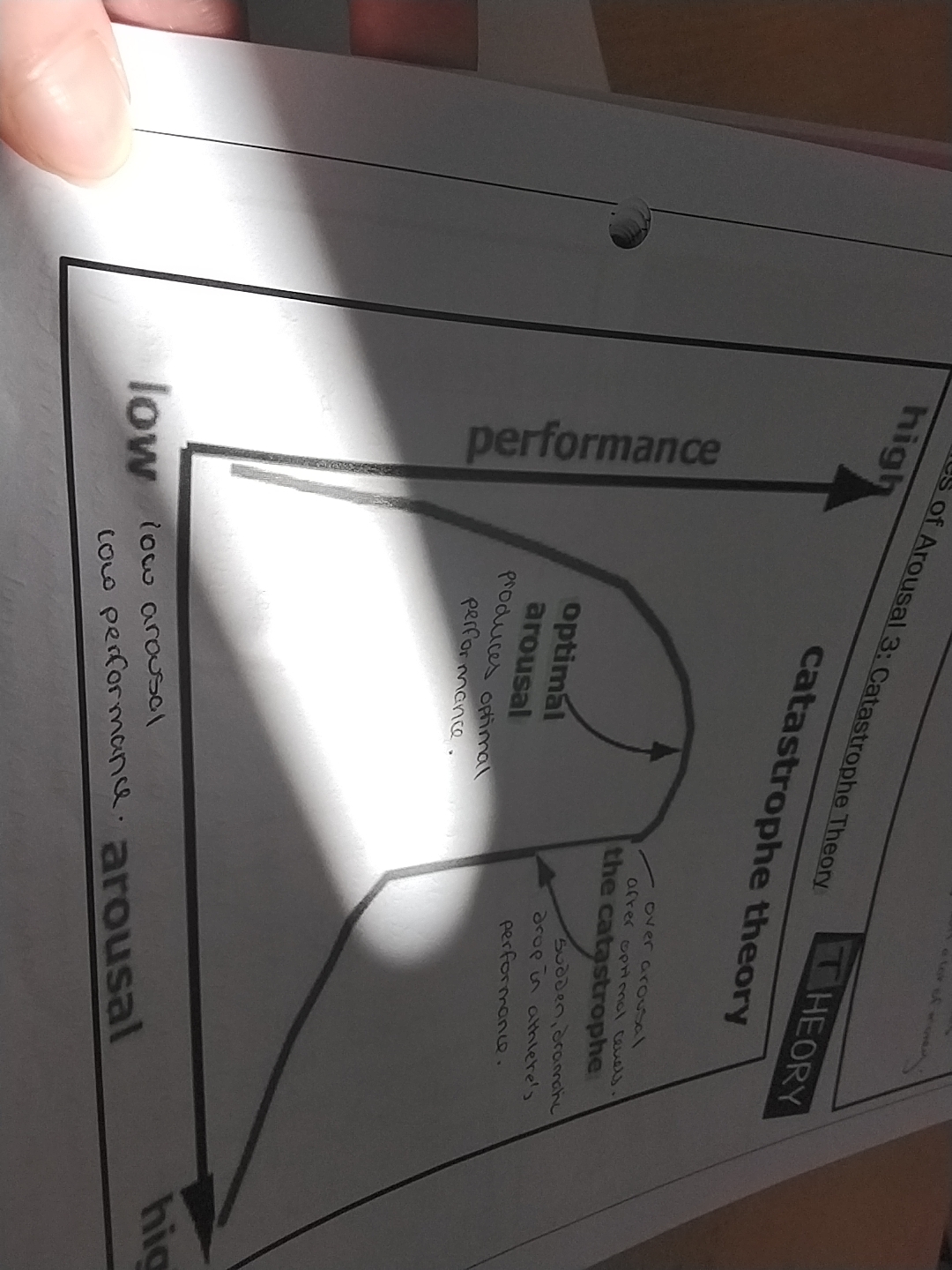
who proposed the catastrophe theory and when
hardy in 1990
why was the catastrophe theory put forward
to support the inverted U theory but highlights that this should only be used for athletes who are free from stress that could affect their mood.
what does the catastrophe theory suggest
if an athlete is high in worry, their performance can follow the inverted U beyond the optimal arousal point and it is possible for catastrophe to occur and a dramatic decrease in performance will result.
what does IZOF stand for
individual zones of optimal functioning
who developed IZOF and when
hanin in 1978
what does IZOF explain
everyone has dfferent optimum levels of arousal.
different people can remain optimally aroused for different periods of time resulting in performing at a higher level for a longer period.
what does IZOF see optimum arousal as
as a bandwidth
at low levels of arousal how would you describe an athlete's attention field
broad.
what happens to attention, as arousal increases
attention narrows and irrelevent cues are ignored o you can focus on the relevent cues.
if arousal goes past the optiml, what happens to attention field.
attention continues to narrow adnd performance may deteriorate as player scans the attentional field less.
who proposed the idea of flow states and when
cziksentmihalyi in 2008
flow states
a state in which people are involved in an activity that nothing else seems to matter ; the experience is so enjoyable that people willcontinue to do it even at great cost, for the sheer sake of it.
what is flow related to
when a person may be so absorbed in an activity that they completely lose track of time and fail to notice that the activity is challenging, captivating and expanding their skills.
what happens to athletes when they experience flow
being more alert, in control, operating in the subconscious, working at the peak of their abilities.
how does low and heigh arousal levels affect concentration and focus
low arousal = low concentration and focus
high arousal = heightened concentration and focus.
what does excessively heightened concentration and focus do and why
hinder athletic performance because it can lead to hypersensitivity to irrelevent stimuli or blind athletes to other relevent information.
who developed the factor of choking and when
gladwell in 2000
choking
performance decrements under pressure conditions despite an individual striving to perform well.
who defined the factor of stress
Mcgrath in 1970
stress
a substantial imbalance between the demand (both physiological and psychological) and responce capability under conditions where failure to meet the demand has important consequences.
who developed the human performance and stress curve and when
Yerkes-Dodson in 1908
draw the human performance and stress curve.
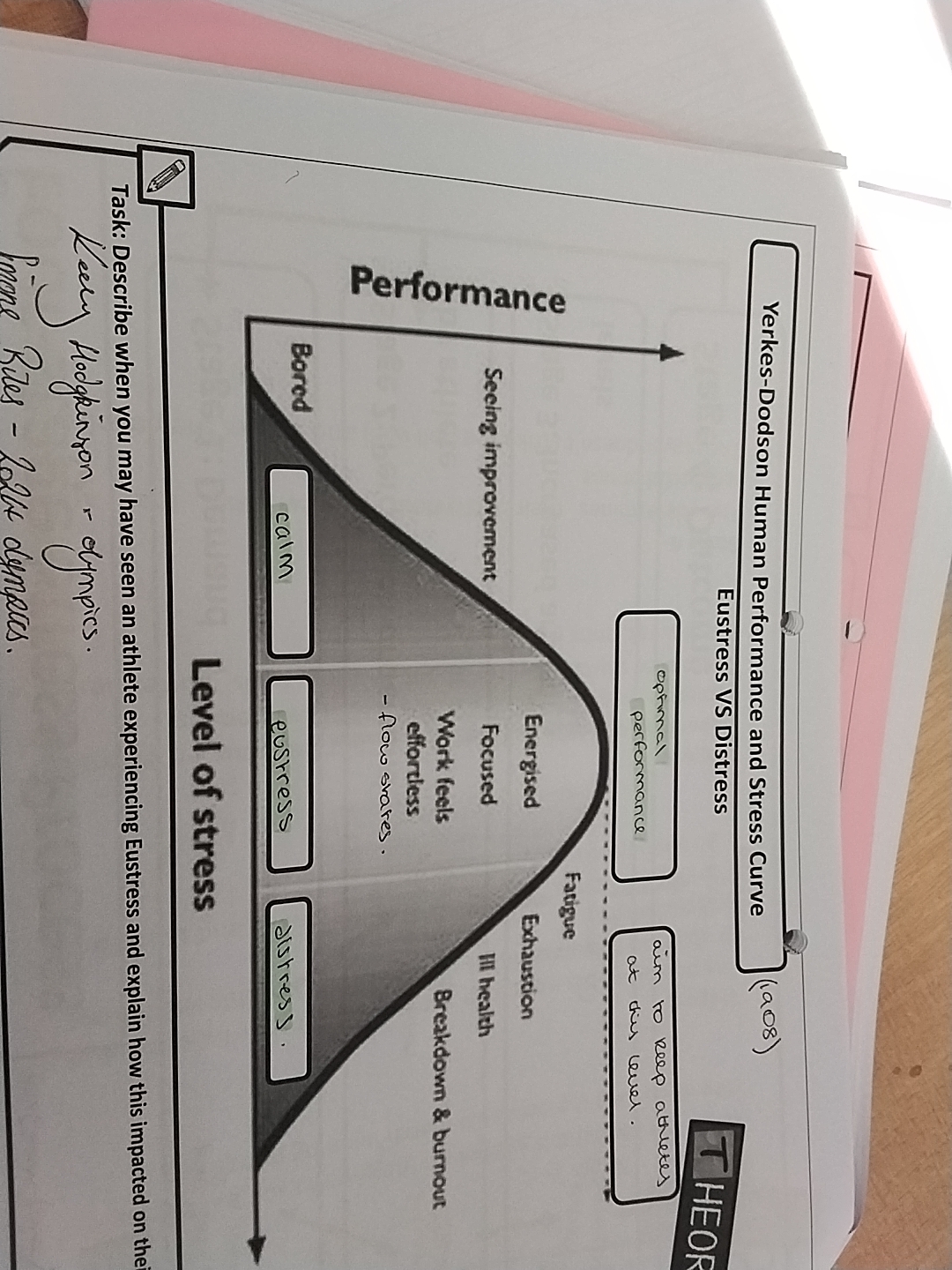
what are the three levels of stress according to the human performance and stress curve
calm,eustress and distress
what is the optimal level of stress
eustress.
what is beyond the optimal levelof stress
distsress.
who developed the four-stage process and when
MCGrath in 1970
what are the four stages in the stress process
demand, perception of demand by the athletes, increased arousallevels, outcome.
who defned the factor of anxiety and when
Honeybourne n 2003
anxiety
the negative affect of experiencing stress .It is the worry that is experienced due to a fear of failure.
what are the six types of anxiety
trait, state, cognitive, somatic, behavioural and competitive anxiety.
trait anxiety
anxiety is and ednduring aspect of an individual's personality.they often have the tendency to view situations as threatening.
state anxiety.
is a temporary, ever-changing mood state to any situation considered threatening.
cognitive anxiety and examples.
experiencing the psychological symptoms of anxiety.
overwhelmed, nerves,worried,anxious, hyperfocussed, loss of concentration, negative mindset.
somatic anxiety and examples
experiencing the physical symptoms of anxiety
increased brething, hot, sweaty, nausea, tensed muscles, shaking
behavioural anxiety and examples
nerves may affect our behaviour in a number of ways
playing it safe, fidgeting, avoiding eye contact, change in posture, rapid speech.
competitive anxiety and examples
athlete feels tense and inadequate in responce to a competitive situation.Often due to fear. Also could be due to changes in a set routine. may be due to confusion or ambiguity.
who developed the multidimensional anxiety theory and when
martens et al 1990
draw the multidimensional anxiety theory
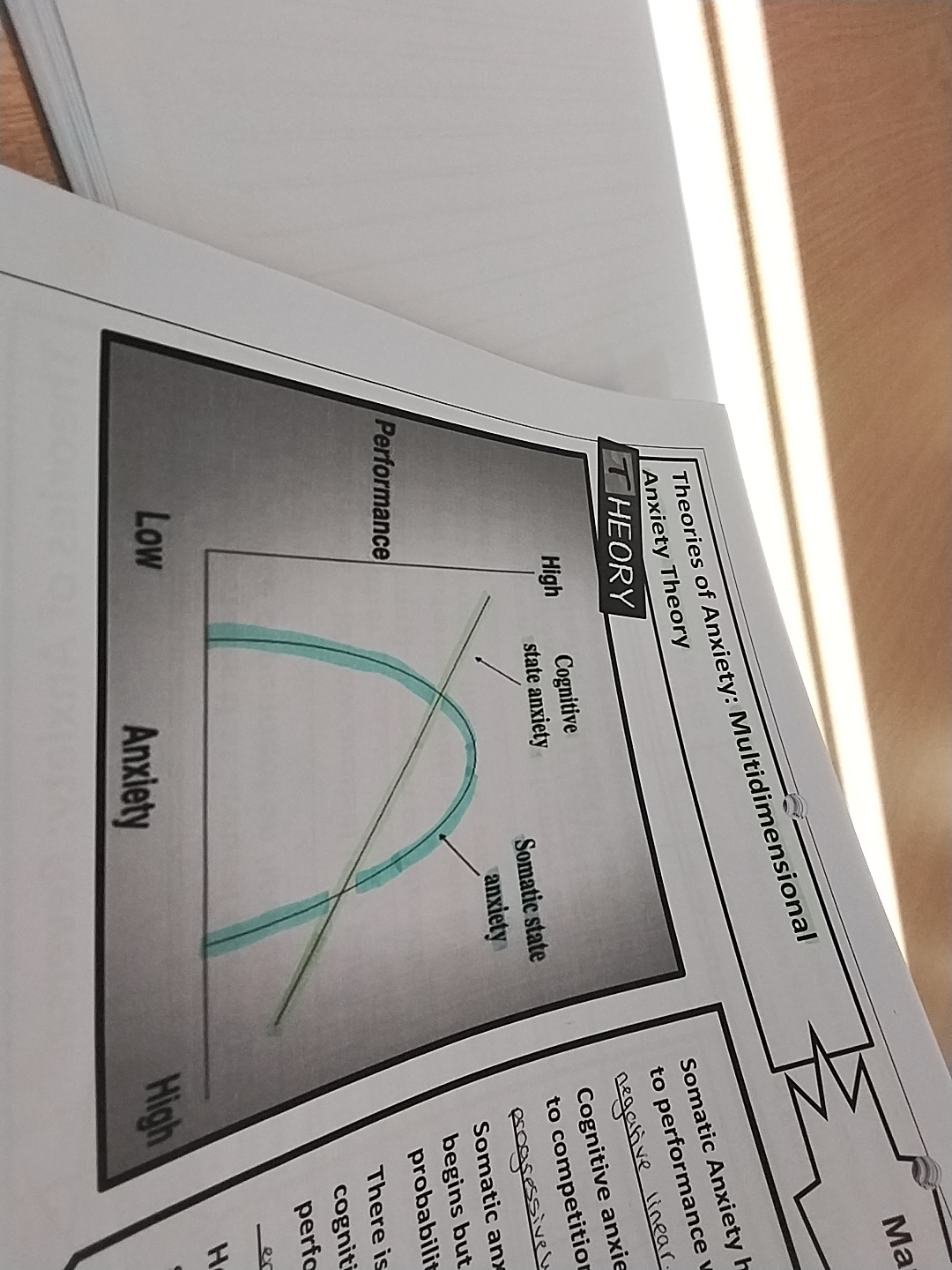
what is the relationship between somatic anxiety and performance
curvilinear relationship
what is the relationship between cognitive anxiety and performance
negative linear relationship.
what happens to the two anxiety types prior to competition according to the multidimensional theory
cognitive stays stable prior to competition whilst somatic increases progressively.
what happens to the two anxiety types during competition according to the multidimensional theory
somatic dissipates but cognitive can vary because the probability of success can change.
how do the two types of anxiety effect performance
cognitive decreases performance and somatic enhances performance.
what are the two types of stress
internal and external
internal sources of stress examples
lack of sleep, fear of failure, self esteem issues, illness
external sources of stress examples.
noisy environment, financial issues, life changng events, bust training schedule.
what are the two categories for symptom of stress
sympathetic and parasympathetic
sympathetic symptoms of stress
heart rate and blood pressure increase
respiration rate increases
blood sugar is released from the liver
adrenaline and noradrenaline are released
fight or flight responce
parasympatheic symptoms of stress
heart rate slows down
blood pressure reduces
respiration returns to resting rate
rest or digest responce
positive consequences of stress
increased energy due to release of adrenaline
increased focus
increased pressue = increased performance
negative consequences of stress
loss of confidence
aggression
burn out
negative mental state
reduced performance
who defined aggression and when
baron and richardson in 1994
aggression
any form of behaviour directed toward the goal of harming / injuring another live being who is motivaated to avoid such treatment.
what four points does gill's criteria include
aggression is a learnt behaviour
aggression is intentional,it cannot be accidental
aggression involves harm which can be physical or verbal
aggression involves living beings.
what does gill's criteria do
helps us to decide whether something can be considered aggressive or not.
what are the three types of aggression
hostile aggression
instrumental aggression
assertion
hostile aggression